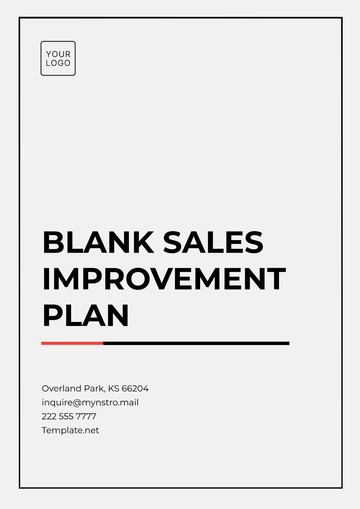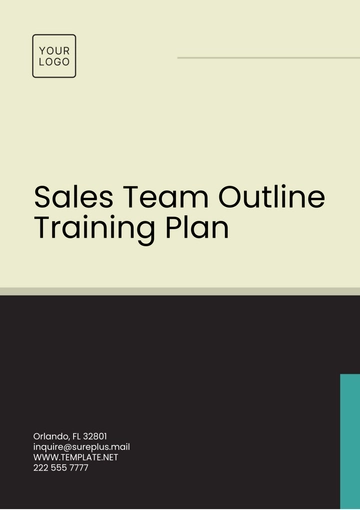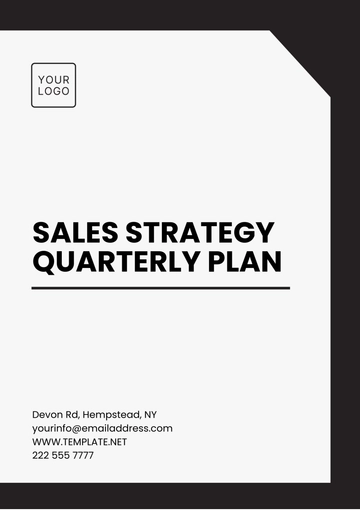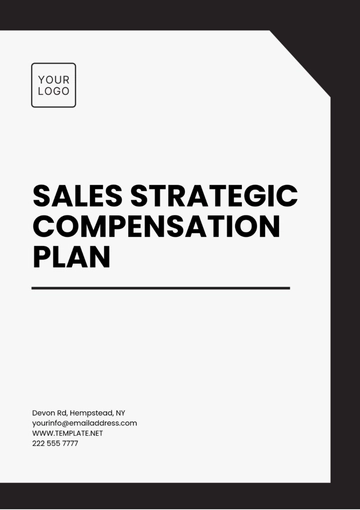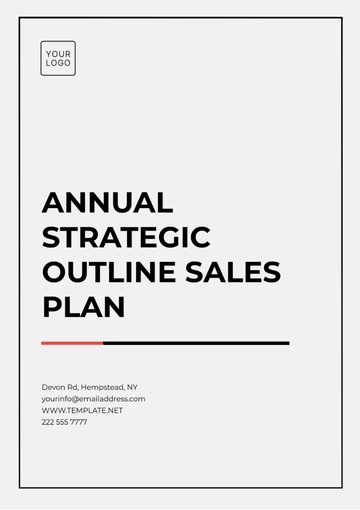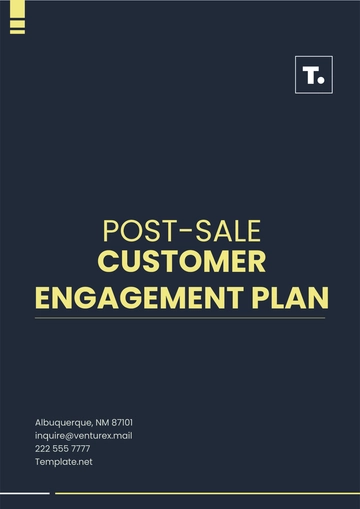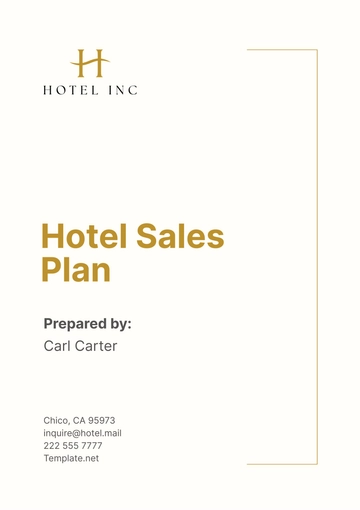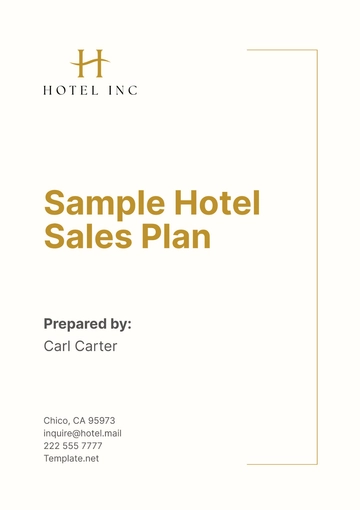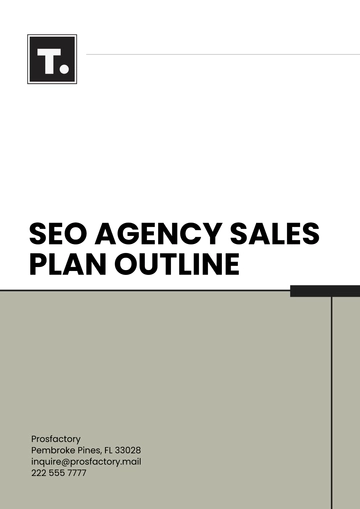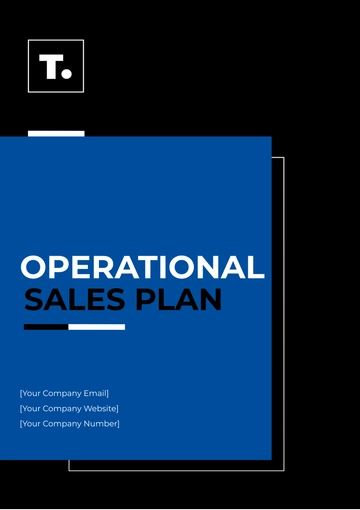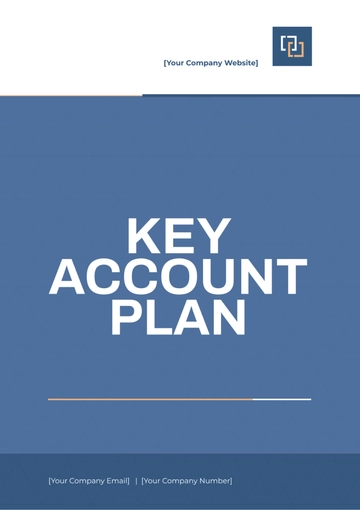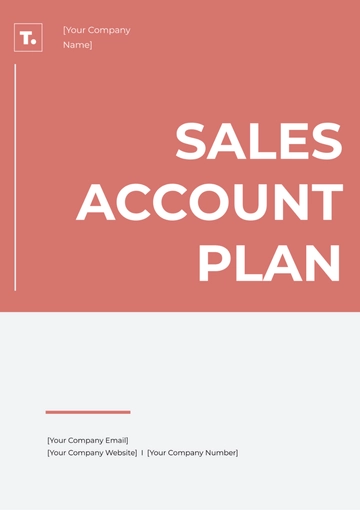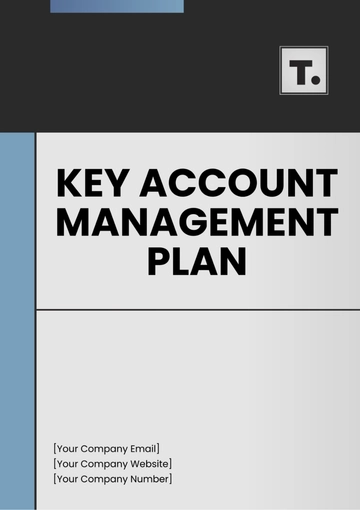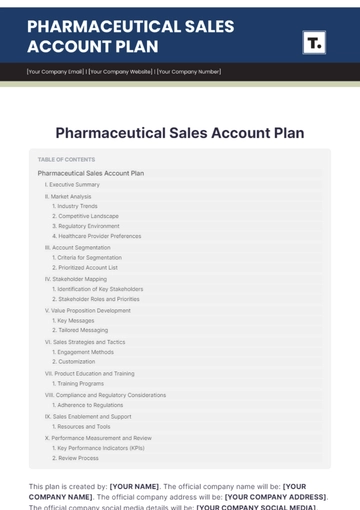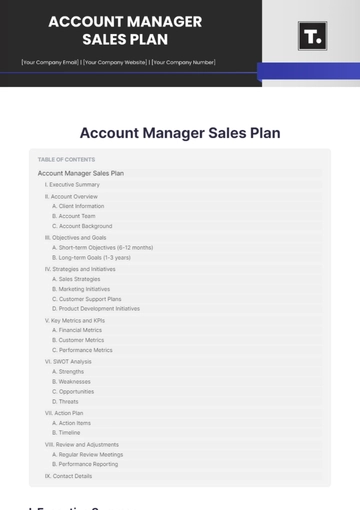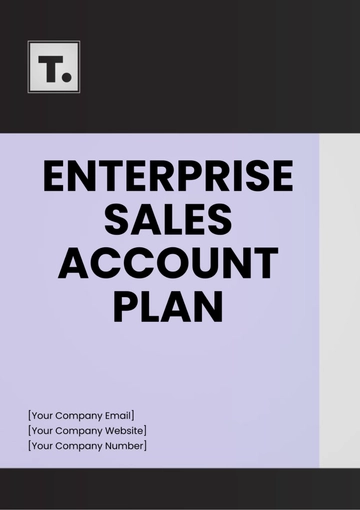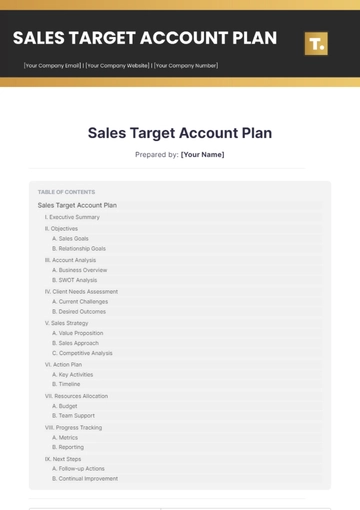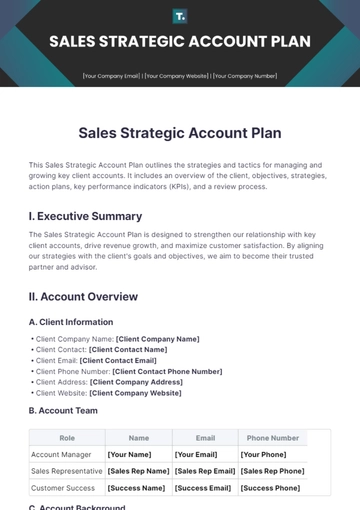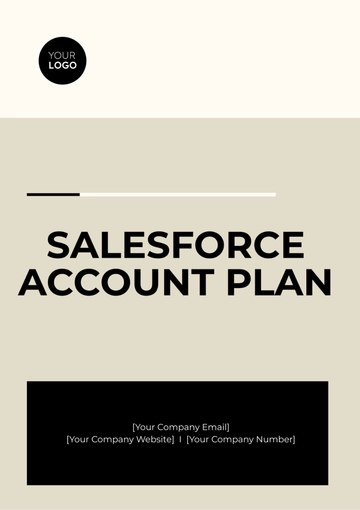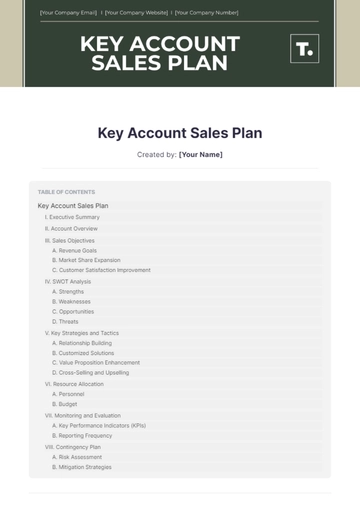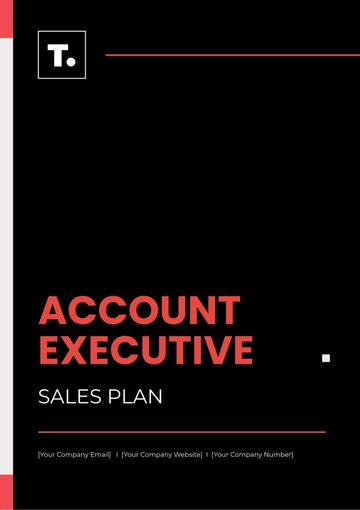Free B2B Sales Plan
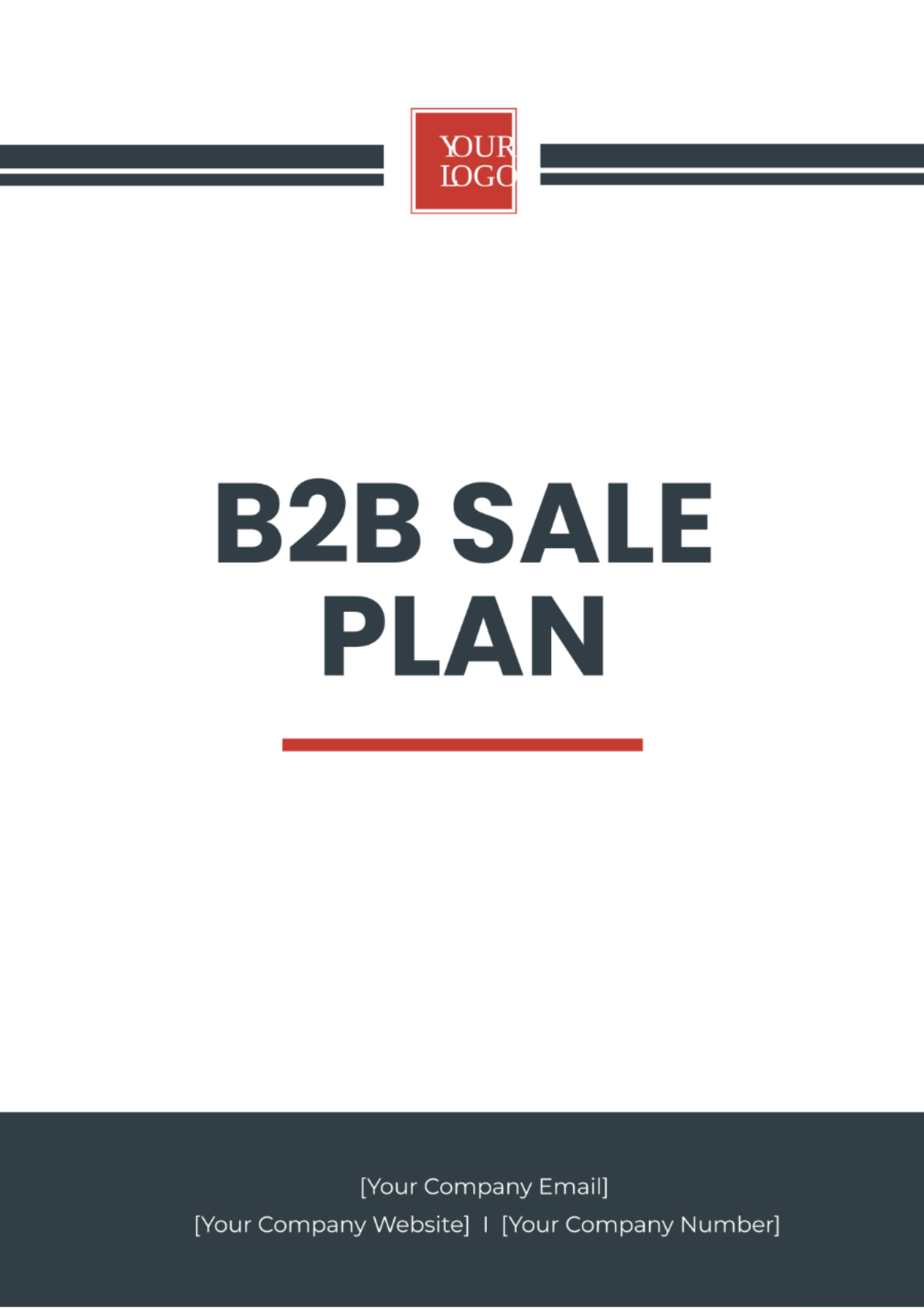
Prepared By: | [Your Name] |
Department: | [Your Department] |
Date: | [Date] |
I. Executive Summary
This B2B Sales Plan for [Your Company Name] outlines the strategies, tactics, and performance metrics to achieve our sales goals for the upcoming fiscal year. Our primary objective is to increase market share and become the leading provider of [Your Product/Service] in the [Your Industry].
II. Goals and Objectives
Our primary goals for the sales plan include:
Attaining a sales revenue goal of ten million dollars before the conclusion of the fiscal year.
Expanding our customer base by 50 new B2B clients.
Improving the customer retention rate by elevating it from 80% to 85%.
Aiming to expand our market share by 10 percent in the segment of Healthcare Information Technology Solutions.
III. Market Analysis
A. Target Market
Our target market consists of businesses in the [Your Industry] sector, specifically focusing on:
Hospital Management Systems Providers (Segment 1):
Description: Companies that specialize in providing software solutions for hospital management, including electronic health records (EHR), patient management, billing, and scheduling systems.
Characteristics: Typically larger healthcare IT companies with established market presence and a wide range of integrated solutions.
Targeted Approach: Tailored marketing campaigns highlighting compatibility, scalability, and integration capabilities with existing hospital systems.
Telemedicine and Remote Monitoring Providers (Segment 2):
Description: Companies offering telemedicine platforms, remote patient monitoring solutions, and virtual care technologies.
Characteristics: Innovators in the healthcare IT space, focusing on remote healthcare delivery, patient engagement, and data analytics.
Targeted Approach: Highlighting the benefits of remote patient care, data security, and interoperability with existing healthcare systems to attract these specialized providers.
Healthcare Analytics and Business Intelligence Providers (Segment 3):
Description: Companies specializing in healthcare analytics, business intelligence tools, and data-driven decision-making solutions for healthcare organizations.
Characteristics: Data-centric companies offering insights into clinical outcomes, financial performance, and operational efficiency for healthcare providers.
Targeted Approach: Emphasizing data accuracy, predictive analytics, and actionable insights to help healthcare organizations improve patient care outcomes and operational efficiency.
B. Competitive Analysis
A detailed analysis of our key competitors includes:
Competitor | Strengths | Weaknesses |
[Competitor 1] | Established market presence with a large customer base. | Higher pricing, limiting market penetration in smaller facilities. |
Comprehensive healthcare management suite (EHR, billing, patient engagement). | Limited focus on specialized telemedicine and remote monitoring solutions. | |
[Competitor 2] | Innovative telemedicine platform for virtual consultations. | Limited market visibility impacts brand recognition. |
Customizable solutions for specific healthcare needs, enhancing satisfaction. | Challenges in interoperability cause integration issues with hospital management systems for clients. |
C. SWOT Analysis
An internal analysis of [Your Company Name] reveals the following strengths, weaknesses, opportunities, and threats:
Strengths | Weaknesses |
|---|---|
Highly skilled and experienced sales team with a track record of exceeding targets. | Limited presence in emerging markets or geographical regions. |
Strong brand reputation and recognition in the healthcare IT solutions market. | Reliance on outdated sales technologies and tools affects efficiency. |
Opportunities | Threats |
Growing demand for telemedicine and remote patient monitoring solutions in the healthcare sector. | Intense competition from established players with larger market shares. |
Expansion opportunities in untapped market segments such as small clinics and private practices. | Regulatory changes impacting healthcare IT compliance standards and requirements. |
IV. Sales Strategies
A. Lead Generation
To generate leads, we will employ the following strategies:
Content Marketing: Create valuable content such as blogs, whitepapers, and guides related to healthcare IT solutions. Optimize content for relevant keywords to attract organic traffic and leads through search engines.
Social Media Outreach: Leverage platforms like LinkedIn, Twitter, and industry-specific forums to engage with healthcare professionals, share informative content, participate in discussions, and build relationships that can lead to sales opportunities.
Email Campaigns: Develop targeted email campaigns focused on educating prospects about our healthcare IT solutions' benefits, showcasing case studies, and offering exclusive content or promotions to encourage engagement and conversions.
Networking Events: Attend and host virtual and physical networking events, conferences, and webinars within the healthcare industry to connect with potential clients, demonstrate expertise, and generate leads through direct interactions.
B. Sales Funnel Management
Prospecting: Identify and research potential leads within target market segments, utilizing CRM tools and databases to gather relevant information and prioritize prospects based on their needs and fit with our solutions.
Qualification: Conduct thorough qualification processes to assess lead readiness, budget, decision-making authority, and alignment with our solutions. Determine if leads meet the criteria for further engagement.
Needs Analysis: Engage qualified leads in detailed discussions or consultations to understand their pain points, challenges, and specific requirements related to healthcare IT solutions. Tailor solution presentations and proposals accordingly.
Proposal: Develop customized proposals outlining solution features, benefits, pricing structures, and implementation timelines based on the needs analysis. Highlight unique value propositions and ROI for the client.
Negotiation: Negotiate terms, pricing, and service levels based on client feedback and requirements. Address objections, provide clarifications, and work towards mutually beneficial agreements.
Closing: Secure contracts and agreements through formalized processes, obtaining necessary approvals and signatures. Ensure smooth transitions to implementation and deployment stages.
After-Sales Support: Provide ongoing support, training, and maintenance services post-sale to ensure client satisfaction, retention, and potential upselling or cross-selling opportunities in the future. Regularly assess and optimize the sales funnel for improved efficiency and effectiveness.
C. Customer Relationship Management (CRM)
We will employ a CRM system to track interactions and manage relationships with our clients, ensuring:
Maintained Customer Profiles
Data Collection: Capture detailed information about clients, including contact details, purchase history, preferences, and interactions.
Segmentation: Organize clients into segments based on industry, size, behavior, or specific needs for targeted marketing and personalized communication.
Activity Tracking: Monitor and record customer interactions, inquiries, and support requests to maintain up-to-date customer profiles.
Timely Follow-ups
Automated Reminders: Set reminders and notifications for follow-up tasks such as calls, meetings, or email responses based on predefined timelines or triggers.
Task Assignment: Assign follow-up tasks to sales or support team members within the CRM system, ensuring accountability and timely actions.
Integration with Communication Channels: Sync email conversations, call logs, and meeting notes directly into customer profiles for seamless follow-up and continuity.
Effective Communication
Centralized Communication: Store all communications, including emails, calls, and notes, within the CRM platform for easy access and reference by team members.
Personalized Messaging: Use customer data and segmentation insights to personalize communication, addressing specific needs and interests.
Campaign Management: Create and manage targeted marketing campaigns directly within the CRM system, tracking responses and engagement for follow-up actions.
V. Sales Team Structure
Sales Director: The Sales Director oversees sales strategy, collaborates on targets, strategies, and budgets with senior management, and analyzes market trends for decision-making. They mentor the sales team, ensuring alignment with company values and best practices.
Account Managers: Account Managers nurture key client relationships, understand client needs, and ensure timely delivery of solutions, fostering customer loyalty. They collaborate with internal teams for coordinated efforts and maximum client value.
Sales Representatives: Sales Representatives focus on lead generation, leveraging customer insights to convert leads into customers. They use CRM tools and analytics for proactive sales approaches and process optimization.
Customer Support: The Customer Support team handles post-sales activities, addressing inquiries, troubleshooting issues, and maintaining positive customer experiences for retention and referrals. They also provide product education and training as needed.
VI. Performance Metrics
Sales Revenue: Measure total revenue generated from sales of healthcare IT solutions within the fiscal year.
Amount: $10 million
Customer Acquisition Cost (CAC): Calculate the average cost incurred to acquire a new B2B client, including sales and marketing expenses.
Amount: $5,000 per new client
Customer Lifetime Value (CLTV): Determine the total value a customer brings to the company over their entire relationship, considering revenue and retention.
Amount: $50,000 over 5 years
Conversion Rate: Track the percentage of leads that convert into paying customers, indicating sales effectiveness.
Amount: 20% conversion rate
Client Retention Rate: Calculate the percentage of customers retained over a specific period, reflecting customer satisfaction and loyalty efforts.
Amount: 85% retention rate
Sales Cycle Length: Measure the average time taken from initial contact to closing a sale, assessing sales process efficiency and effectiveness.
VII. Adaptability Strategies
To maintain our flexibility and adaptability in response to fluctuations and transformations within the market, we are committed to taking the following steps:
Conduct Quarterly Reviews: Regularly assess sales performance, strategies, and goals every quarter to identify areas for improvement and adjustments.
Implement Feedback Loops: Establish mechanisms for gathering feedback from customers, sales teams, and stakeholders to inform decision-making and refine strategies.
Monitor Industry Trends: Stay updated on healthcare IT industry trends, competitor activities, and market dynamics to anticipate changes and adjust strategies proactively.
Adjust Sales Tactics as Needed: Flexibly modify sales approaches, campaigns, and tactics based on insights from reviews, feedback, and industry trends to remain competitive and meet evolving customer needs.
VIII. Resource Allocation
We will allocate the necessary resources to support our sales team and strategies, including:
Budget for Marketing and Advertising: $500,000
Investment in CRM Tools: $100,000 for implementing and maintaining a robust CRM system.
Training and Development Programs: $50,000 for sales team training, workshops, and skill development programs.
Sales Incentive Programs: $200,000 for performance-based bonuses, rewards, and recognition programs to motivate and incentivize the sales team.
IX. Conclusion
This sales plan sets the foundation for [Your Company Name] to achieve its B2B sales goals and fortify its market presence. By following this structured approach, we are confident in our ability to succeed and drive substantial business growth.
- 100% Customizable, free editor
- Access 1 Million+ Templates, photo’s & graphics
- Download or share as a template
- Click and replace photos, graphics, text, backgrounds
- Resize, crop, AI write & more
- Access advanced editor
Create a robust sales strategy with Template.net's B2B Sales Plan Template. This editable and customizable template is designed to help you plan and execute effective sales tactics. Editable in our AI Editor Tool, it allows for personalized adjustments to fit your business needs. Elevate your B2B sales with this comprehensive and practical plan tailored for success.
You may also like
- Finance Plan
- Construction Plan
- Sales Plan
- Development Plan
- Career Plan
- Budget Plan
- HR Plan
- Education Plan
- Transition Plan
- Work Plan
- Training Plan
- Communication Plan
- Operation Plan
- Health And Safety Plan
- Strategy Plan
- Professional Development Plan
- Advertising Plan
- Risk Management Plan
- Restaurant Plan
- School Plan
- Nursing Home Patient Care Plan
- Nursing Care Plan
- Plan Event
- Startup Plan
- Social Media Plan
- Staffing Plan
- Annual Plan
- Content Plan
- Payment Plan
- Implementation Plan
- Hotel Plan
- Workout Plan
- Accounting Plan
- Campaign Plan
- Essay Plan
- 30 60 90 Day Plan
- Research Plan
- Recruitment Plan
- 90 Day Plan
- Quarterly Plan
- Emergency Plan
- 5 Year Plan
- Gym Plan
- Personal Plan
- IT and Software Plan
- Treatment Plan
- Real Estate Plan
- Law Firm Plan
- Healthcare Plan
- Improvement Plan
- Media Plan
- 5 Year Business Plan
- Learning Plan
- Marketing Campaign Plan
- Travel Agency Plan
- Cleaning Services Plan
- Interior Design Plan
- Performance Plan
- PR Plan
- Birth Plan
- Life Plan
- SEO Plan
- Disaster Recovery Plan
- Continuity Plan
- Launch Plan
- Legal Plan
- Behavior Plan
- Performance Improvement Plan
- Salon Plan
- Security Plan
- Security Management Plan
- Employee Development Plan
- Quality Plan
- Service Improvement Plan
- Growth Plan
- Incident Response Plan
- Basketball Plan
- Emergency Action Plan
- Product Launch Plan
- Spa Plan
- Employee Training Plan
- Data Analysis Plan
- Employee Action Plan
- Territory Plan
- Audit Plan
- Classroom Plan
- Activity Plan
- Parenting Plan
- Care Plan
- Project Execution Plan
- Exercise Plan
- Internship Plan
- Software Development Plan
- Continuous Improvement Plan
- Leave Plan
- 90 Day Sales Plan
- Advertising Agency Plan
- Employee Transition Plan
- Smart Action Plan
- Workplace Safety Plan
- Behavior Change Plan
- Contingency Plan
- Continuity of Operations Plan
- Health Plan
- Quality Control Plan
- Self Plan
- Sports Development Plan
- Change Management Plan
- Ecommerce Plan
- Personal Financial Plan
- Process Improvement Plan
- 30-60-90 Day Sales Plan
- Crisis Management Plan
- Engagement Plan
- Execution Plan
- Pandemic Plan
- Quality Assurance Plan
- Service Continuity Plan
- Agile Project Plan
- Fundraising Plan
- Job Transition Plan
- Asset Maintenance Plan
- Maintenance Plan
- Software Test Plan
- Staff Training and Development Plan
- 3 Year Plan
- Brand Activation Plan
- Release Plan
- Resource Plan
- Risk Mitigation Plan
- Teacher Plan
- 30 60 90 Day Plan for New Manager
- Food Safety Plan
- Food Truck Plan
- Hiring Plan
- Quality Management Plan
- Wellness Plan
- Behavior Intervention Plan
- Bonus Plan
- Investment Plan
- Maternity Leave Plan
- Pandemic Response Plan
- Succession Planning
- Coaching Plan
- Configuration Management Plan
- Remote Work Plan
- Self Care Plan
- Teaching Plan
- 100-Day Plan
- HACCP Plan
- Student Plan
- Sustainability Plan
- 30 60 90 Day Plan for Interview
- Access Plan
- Site Specific Safety Plan


